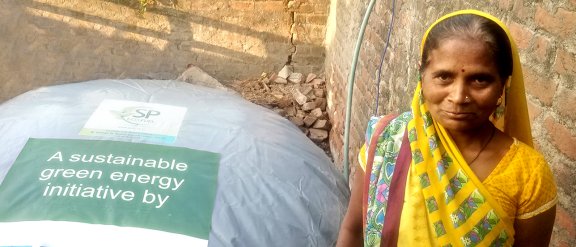Introduction
To heat their homes, villagers in places like Dahej, India must search for firewood, which is both a time-consuming and back-breaking process.
Technip Energies helped install a biogas plant at my home, simplifying my daily routine. I used to put cow dung into village pits, but now it provides me with cooking gas. I also don't need to gather firewood, so I can cook through monsoon season."
Challenge
Improving community well-being and reducing CO2 emissions
Clean and affordable sources of energy are hard to come by in economically challenged locales such as the villages around Dahej, around 180 miles north of Mumbai on India's Arabian Coast.
Women are often tasked with collecting firewood or making cow dung cakes as fuel for food preparation. This labor-intensive process is made more difficult during monsoon season, when dry wood and dung are in short supply. Additionally, villagers' health is impacted by the poor indoor air quality due to the burning of these materials.
Solution
Turning waste into energy
As part of its corporate responsibility approach, Technip Energies India aimed to find an economical solution for five villages near its modular manufacturing yard in Dahej. After assessing a short site survey, it undertook the installation of biogas plant of three cubic meter size in 100 rural households.
Low-maintenance biogas plants for clean, low-cost energy
Biogas plants utilize anaerobic digestion, where biomass (such as cow dung) is digested by microbes in the absence of oxygen, naturally generating biogas. Technip Energies India's Flexi Biogas plant proved to be an easy fit with villagers, requiring minimal civil construction and maintenance.
Cow dung slurry, along with leftover feedstock and organic waste, is put into the unit's inlet tank. The slurry passes into the biogas digesters, where anaerobic digestion occurs, followed by methanogenesis. The ensuing formation of biogas is then used as a fuel for cooking.
A social enterprise was also set up to ensure proper safety and maintenance of the units.
Results
Biogas benefits
Aligned with Technip Energies' strategic social and environmental objectives, the biogas project has seen great success. It has enabled an overall healthier lifestyle, providing villagers access to low cost- and labor-intensive methods of obtaining cooking fuel. Villagers are using clean energy and at the same time helping limit CO2 emissions to the tune of 250 metric tons of CO2 annually.
This also has proved a boon to women, who now are not burdened with the chore of collecting firewood or making dung cakes. Farmers are also benefitted, as the digested slurry is a rich source of manure, which reduces reliance on chemical fertilizers.
